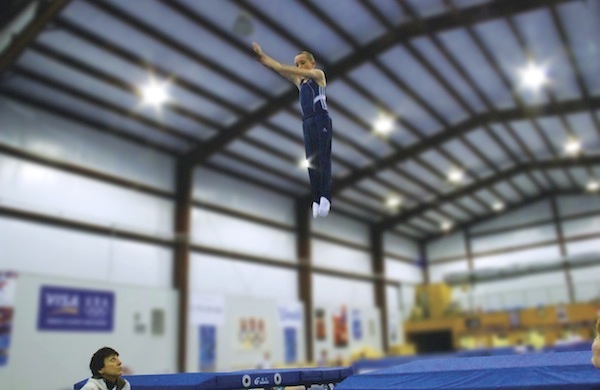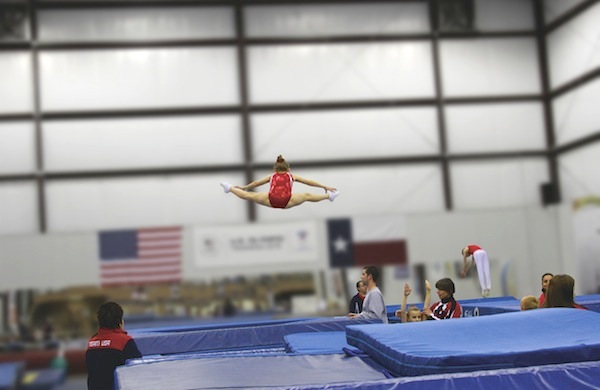 In neighborhoods across America, there’s the kid with the trampoline. This kid usually makes friends pretty quickly, seeing as how every other kid on the block desperately wants to hang out in their backyard. “We personally did not ever own a backyard trampoline,” recalls Susan Jacobson, the program director of Trampoline and Tumbling at USA Gymnastics. “[My children] would go to their friends’ house, and the parents would say, ‘Oh my gosh, it was so funny. Your kids were like little teachers.’” Apparently, Jacobson’s kids had learned a thing or two about trampoline safety from their mom. “They actually freaked out when they saw 20 kids on the trampoline,” Jacobson remembers with a laugh. “They told them they were all going to get hurt, and to get off and line up.” Jacobson may smile at the memory, but she takes pride in having instilled a sense of safety in her kids. Of course, not every mom can work for Team USA, and Jacobson knows there are still a lot of misconceptions about the sport and gymnastics in general. We gave her the opportunity to set the record straight about everything trampolining, from the safety protocol to the surprising health and fitness benefits. Here are the top five things she thinks you should know.
In neighborhoods across America, there’s the kid with the trampoline. This kid usually makes friends pretty quickly, seeing as how every other kid on the block desperately wants to hang out in their backyard. “We personally did not ever own a backyard trampoline,” recalls Susan Jacobson, the program director of Trampoline and Tumbling at USA Gymnastics. “[My children] would go to their friends’ house, and the parents would say, ‘Oh my gosh, it was so funny. Your kids were like little teachers.’” Apparently, Jacobson’s kids had learned a thing or two about trampoline safety from their mom. “They actually freaked out when they saw 20 kids on the trampoline,” Jacobson remembers with a laugh. “They told them they were all going to get hurt, and to get off and line up.” Jacobson may smile at the memory, but she takes pride in having instilled a sense of safety in her kids. Of course, not every mom can work for Team USA, and Jacobson knows there are still a lot of misconceptions about the sport and gymnastics in general. We gave her the opportunity to set the record straight about everything trampolining, from the safety protocol to the surprising health and fitness benefits. Here are the top five things she thinks you should know.  1. Anyone can do it. Trampolining “gets the heart going,” Jacobson says. “I’ve had kids come in that … had never participated in any kind of physical activity. Just bouncing up and down without even leaving the [trampoline] bed got their heart rate up. If you think about jumping rope, and how hard it is to jump rope for even 30 seconds, trampolining provides that same environment.” The one difference? Anyone can do it. “It’s [also] a low-impact activity,” Jacobson notes, “so it’s easy on the joints.” 2. Stopping is just as important as jumping. According to Jacobson, stopping is the very first skill students actually learn. “Often, parents are scared [their kids] are going to fly off,” she says. “[So] with our tiniest preschoolers, we call it ‘1, 2, 3, grab your knees.’ They learn to not let the springs push them off. If anything happens where they’re bouncing toward the edge, then they learn how to stop and get back to a place that’s safe.”
1. Anyone can do it. Trampolining “gets the heart going,” Jacobson says. “I’ve had kids come in that … had never participated in any kind of physical activity. Just bouncing up and down without even leaving the [trampoline] bed got their heart rate up. If you think about jumping rope, and how hard it is to jump rope for even 30 seconds, trampolining provides that same environment.” The one difference? Anyone can do it. “It’s [also] a low-impact activity,” Jacobson notes, “so it’s easy on the joints.” 2. Stopping is just as important as jumping. According to Jacobson, stopping is the very first skill students actually learn. “Often, parents are scared [their kids] are going to fly off,” she says. “[So] with our tiniest preschoolers, we call it ‘1, 2, 3, grab your knees.’ They learn to not let the springs push them off. If anything happens where they’re bouncing toward the edge, then they learn how to stop and get back to a place that’s safe.”  3. You can start practicing on the ground. All of Jacobson’s students learn their moves on the ground before they climb onto the trampoline. Not only is this safer, but it also gives them something fun to do while waiting their turn. “When kids are down on the ground,” she explains, “they’re pulling their knees up, bending their knees and grabbing their shoes, then letting them go. The next four kids are standing in line doing touch jumps.” The best part about this process? “It keeps everybody moving.” 4. Trampolining is like squatting, only easier. “[With] our highest-level athletes,” Jacobson explains, “the pressure of their bodies is going 6 to 9 Gs at the bottom of the bed. So your average person is probably doing two to three times their body weight. If you think about that, a guy that’s 150 pounds is suddenly doing a 450-pound squat.” 5. Beginners shouldn’t try to flip. When bouncing on a trampoline, the first instinct is often to flip in the air. Unless you have the proper experience, that’s a big no-no. “The risk of injury increases any time you go upside-down,” Jacobson warns. “There are over 100 things you should learn” before trying out a flip, but “that’s a whole other article,” she says with a laugh. “The only reason kids want to flip is because they’ve seen it from others, and they don’t know what else to do … The minute you give them something else, it becomes a non-issue.”
3. You can start practicing on the ground. All of Jacobson’s students learn their moves on the ground before they climb onto the trampoline. Not only is this safer, but it also gives them something fun to do while waiting their turn. “When kids are down on the ground,” she explains, “they’re pulling their knees up, bending their knees and grabbing their shoes, then letting them go. The next four kids are standing in line doing touch jumps.” The best part about this process? “It keeps everybody moving.” 4. Trampolining is like squatting, only easier. “[With] our highest-level athletes,” Jacobson explains, “the pressure of their bodies is going 6 to 9 Gs at the bottom of the bed. So your average person is probably doing two to three times their body weight. If you think about that, a guy that’s 150 pounds is suddenly doing a 450-pound squat.” 5. Beginners shouldn’t try to flip. When bouncing on a trampoline, the first instinct is often to flip in the air. Unless you have the proper experience, that’s a big no-no. “The risk of injury increases any time you go upside-down,” Jacobson warns. “There are over 100 things you should learn” before trying out a flip, but “that’s a whole other article,” she says with a laugh. “The only reason kids want to flip is because they’ve seen it from others, and they don’t know what else to do … The minute you give them something else, it becomes a non-issue.”  USA Gymnastics will be competing at the 2014 Trampoline & Tumbling World Championships on November 7–16 in Daytona Beach. Click here for tickets and more info.
USA Gymnastics will be competing at the 2014 Trampoline & Tumbling World Championships on November 7–16 in Daytona Beach. Click here for tickets and more info.  Images courtesy of USA Gymnastics.
Images courtesy of USA Gymnastics.






 In neighborhoods across America, there’s the kid with the trampoline. This kid usually makes friends pretty quickly, seeing as how every other kid on the block desperately wants to hang out in their backyard. “We personally did not ever own a backyard trampoline,” recalls Susan Jacobson, the program director of Trampoline and Tumbling at
In neighborhoods across America, there’s the kid with the trampoline. This kid usually makes friends pretty quickly, seeing as how every other kid on the block desperately wants to hang out in their backyard. “We personally did not ever own a backyard trampoline,” recalls Susan Jacobson, the program director of Trampoline and Tumbling at 
 3. You can start practicing on the ground. All of Jacobson’s students learn their moves on the ground before they climb onto the trampoline. Not only is this safer, but it also gives them something fun to do while waiting their turn. “When kids are down on the ground,” she explains, “they’re pulling their knees up, bending their knees and grabbing their shoes, then letting them go. The next four kids are standing in line doing touch jumps.” The best part about this process? “It keeps everybody moving.” 4. Trampolining is like squatting, only easier. “[With] our highest-level athletes,” Jacobson explains, “the pressure of their bodies is going 6 to 9 Gs at the bottom of the bed. So your average person is probably doing two to three times their body weight. If you think about that, a guy that’s 150 pounds is suddenly doing a 450-pound squat.” 5. Beginners shouldn’t try to flip. When bouncing on a trampoline, the first instinct is often to flip in the air. Unless you have the proper experience, that’s a big no-no. “The risk of injury increases any time you go upside-down,” Jacobson warns. “There are over 100 things you should learn” before trying out a flip, but “that’s a whole other article,” she says with a laugh. “The only reason kids want to flip is because they’ve seen it from others, and they don’t know what else to do … The minute you give them something else, it becomes a non-issue.”
3. You can start practicing on the ground. All of Jacobson’s students learn their moves on the ground before they climb onto the trampoline. Not only is this safer, but it also gives them something fun to do while waiting their turn. “When kids are down on the ground,” she explains, “they’re pulling their knees up, bending their knees and grabbing their shoes, then letting them go. The next four kids are standing in line doing touch jumps.” The best part about this process? “It keeps everybody moving.” 4. Trampolining is like squatting, only easier. “[With] our highest-level athletes,” Jacobson explains, “the pressure of their bodies is going 6 to 9 Gs at the bottom of the bed. So your average person is probably doing two to three times their body weight. If you think about that, a guy that’s 150 pounds is suddenly doing a 450-pound squat.” 5. Beginners shouldn’t try to flip. When bouncing on a trampoline, the first instinct is often to flip in the air. Unless you have the proper experience, that’s a big no-no. “The risk of injury increases any time you go upside-down,” Jacobson warns. “There are over 100 things you should learn” before trying out a flip, but “that’s a whole other article,” she says with a laugh. “The only reason kids want to flip is because they’ve seen it from others, and they don’t know what else to do … The minute you give them something else, it becomes a non-issue.”  USA Gymnastics will be competing at the
USA Gymnastics will be competing at the 